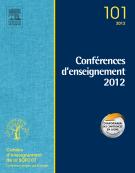Fractures de l’enfant avant l’âge de 18 mois : Fractures in children before the age of 18 months - 14/11/13
| pagine | 15 |
| Iconografia | 12 |
| Video | 0 |
| Altro | 0 |
Résumé |
Les fractures chez l’enfant de moins de 18 mois surviennent avant le seuil habituel d’acquisition de la marche. Le pronostic est favorable quels que soient le type de fracture et les circonstances de survenue. L’étiologie est aisée à déterminer lors des traumatismes obstétricaux, dont les facteurs de risque sont bien identifiés. Le diagnostic est facile pour les fractures diaphysaires, mais plus délicat pour les décollements épiphysaires. Les fractures survenant après le retour du nouveau-né au domicile sont soit dues à des chutes par maladresse, soit d’origine non accidentelle, et il se pose alors une question fondamentale : s’agit-il d’un enfant maltraité, ou bien existe-t-il une fragilité osseuse expliquant la fracture? Les implications médicales, sociales et judiciaires de la réponse sont majeures. La recherche étiologique, souvent fort délicate, bénéficiera de l’implication d’une équipe multidisciplinaire. Cette synthèse de la littérature orientera le chirurgien orthopédiste dans la démarche diagnostique et la prise en charge adaptée à ces petits enfants, dans un contexte législatif français qui évolue beaucoup depuis 25 ans.
Abstract – Fractures in children before the age of 18 months
Fractures in children before the age of 18 months occur before they have started walking. The prognosis is favorable whatever the type and mechanism of the fracture. The etiology is easy to determine for fractures resulting from an obstetrical trauma, as the risk factors have been clearly identified. The diagnosis is straightforward for diaphyseal fractures, but is more delicate for physeal injuries. Fractures arising after the newborn child has been brought to his place of residence may be due to falls as a result of clumsiness or they may not be accidental. A fundamental question then arises: is it a battered or a neglected child or is there an osseous fragility explaining the fracture? The medical, social and judicial implications of the answer are major. The search for the precise etiology is often tricky and will benefit from the implication of a multidisciplinary team. This synthesis of the literature will direct the orthopedic surgeon in the diagnostic approach and the care adapted to these toddlers or newborn children, in a legislative context which has evolved considerably over the past 25 years in France.
Vous pouvez accéder à la vidéo de cette conférence en cliquant Index.html?videoid=1
Mappa
© 2012 Elsevier Masson SAS. Tutti i diritti riservati.
Benvenuto su EM|consulte, il riferimento dei professionisti della salute.
L'accesso al testo integrale di questo articolo richiede un abbonamento o un acquisto all'unità.
Benvenuto su EM|consulte, il riferimento dei professionisti della salute.
L'accesso al testo integrale di questo articolo richiede un abbonamento.
Già abbonato a questo prodotto ?


